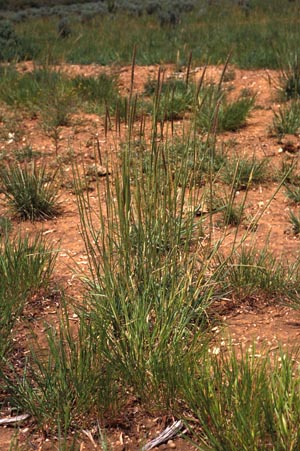Russian Wildrye

Common Name(s):
Russian Wildrye
Scientific Name:
Psathyrostachys juncea (Fisch.) Nevski
Scientific Name Synonyms:
Elymus junceus Fisch.
Symbol:
PSJU3
Description:
Life Span: Perennial
Origin: Introduced
Season: Cool
Growth Characteristics: Russian wildrye is a densely tufted bunchgrass 16-44” tall. It’s stems are erect or decumbent at the base, leafless, and densely tufted. It forms an extensive network of dense, fibrous roots, but is not rhizomatous. It begins growth in early spring and flowers April-June.
Seehead: The seedhead is a spike 1-6” long with 3 spikelets per node that break off both above and below the glumes and are strongly overlapping. The glumes are up to 3/8” long, rough or hairy, and pointed or awn-tipped. Lemmas are longer than the glumes, rough to densely hairy, round-backed, and sharply pointed to awn-tipped.
Leaves: Leaves are predominantly basal. Leaf blades are flat to boat-shaped, ≤¼” wide with short ligules. Sheaths are smooth with well-developed auricles. The leaf sheath bases are usually persistent, often shredding into fibers.
Ecological Adaptions:
Russian wildrye has been planted throughout Utah in salt desert shrub, sagebrush, pinyon-juniper, mountain brush, aspen, and ponderosa pine communities at elevations from 4,000-9,300’ where annual precipitation is greater than 8”. It is long lived, cold, salt, and drought tolerant.
Soils: It is adapted to shallow to deep soils ranging in texture from sandy loam to clay loam.
Associated Species: Associated species depends on the community where Russian wildrye is planted and may include saltbushes, greasewood, big sagebrush, rubber rabbitbrush, crested wheatgrass, Indian ricegrass, needle-and-thread, winterfat, bitterbrush, and Sandberg bluegrass, among others.
Uses and Management:
Russian wildrye provides green forage for livestock and elk, deer, and small mammals beginning in spring and continuing through July. Grazing animals show high preference for its basal leaves. It is grazing tolerant and a common component of revegetation efforts where harsh conditions exist and erosion control is desired. It is very hardy but not shade tolerant. It has low seedling vigor and does not produce much seed.

